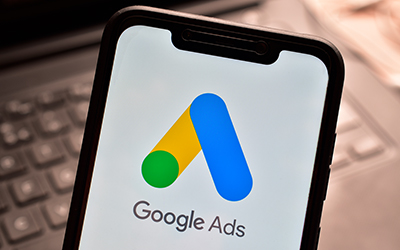Paid Search Best Practices and Strategies for Grad Schools
 Paid search ads (also known as pay-per-click, or PPC ads) can be a powerful marketing tool for graduate schools for many reasons. How so? Paid search best practices and strategies for grad schools allow for specific demographic targeting based on specific criteria, can be turned on to generate leads almost instantly, and offer a lot of flexibility when it comes to crafting your messaging and marketing goals, such as boosting brand awareness, generating demand, or bringing in more qualified leads.
Paid search ads (also known as pay-per-click, or PPC ads) can be a powerful marketing tool for graduate schools for many reasons. How so? Paid search best practices and strategies for grad schools allow for specific demographic targeting based on specific criteria, can be turned on to generate leads almost instantly, and offer a lot of flexibility when it comes to crafting your messaging and marketing goals, such as boosting brand awareness, generating demand, or bringing in more qualified leads.
All of that being said, it’s important to have a strong grasp of how paid search marketing works in order to use it the most effectively. Below, we’ll examine a few strategies and best practices in detail so you know how to effectively leverage it. Let’s take a look.
Research and understand your audience very carefully
Before actually launching any paid search campaigns, always conduct thorough research of your target audience and understand their goals, demographics, and pain points.
This may seem obvious, but all too often paid search campaigns are launched by schools, businesses, and organizations without a clear understanding of who exactly they’re targeting. As a result, many of them waste their time and money on ineffective campaigns. To avoid this, have a strong grasp of who you want to target and for what reasons before budgeting for any paid search campaigns.
Conduct thorough keyword research
Conducting extensive keyword research is also crucial.
Focus on high-volume, relevant keywords with user intent in mind. For example, focusing on a general keyword like “MBA” is too vague and will likely result in squandering your budget, but targeting keywords like “best schools for an EMBA” are much more likely to connect you to the right target audience that’s seeking the programs you’re offering.
By targeting these longtail keywords based on user intent, your campaign will more effectively target the right audience and more effectively funnel leads directly into your specific programs.
A/B test consistently and for many variables
A/B testing is a great way to determine what’s working most effectively in your campaigns and help you optimize them by leveraging this information.
When A/B testing, focus on variables like ad copy, keywords, landing pages, calls-to-action (CTAs), and visuals in both the ad if applicable and landing page. The more information you can glean from A/B testing, the better optimized your campaigns will be, leading to higher conversions without wasting precious dollars.
Determine your goals and KPIs
Setting up specific goals and KPIs early on is critical too.
Without a clear goal and KPIs to track in mind, your campaign will be aimless and end up wasting a lot of time and money. Instead, map out what your specific goals are and the metrics needed to track them before launching a campaign. For example, you may want to set a goal of increasing leads 25% before the start of the next semester. Whatever your goals and KPIs are, be sure that everyone on your team is aware of them and is working towards them with the correct metrics and timelines in mind.
Avoid contact forms that are too long and complex
Finally, avoid contact forms that are too long and complex for your ad landing pages.
While paid ads are great for generating leads and increasing conversions, your efforts may go to waste if your landing page contact forms are too long, overly complex, and invasive in terms of privacy. Instead, keep your contact forms simple, concise, and avoid asking for too much personal information, as many people may be reluctant to give that out early on.
Leverage paid search best practices and strategies for success
By keeping these paid search best practices and strategies for grad schools in mind, you can better optimize your paid search campaigns for your grad school programs. Whatever your goals are, paid search can be a powerful tool when it comes to accomplishing them – if you do it well!

 Although social media has been all the rage over the past few years when it comes to marketing to prospective graduate school students, email remains a very cost-effective and reliable method for communicating with prospects. As with all forms of marketing, email marketing has changed a lot over the years, meaning that higher education institutions need to know the current best practices and strategies to ensure that they’re using it effectively for grad school email marketing.
Although social media has been all the rage over the past few years when it comes to marketing to prospective graduate school students, email remains a very cost-effective and reliable method for communicating with prospects. As with all forms of marketing, email marketing has changed a lot over the years, meaning that higher education institutions need to know the current best practices and strategies to ensure that they’re using it effectively for grad school email marketing. You’ve launched brand awareness and lead generation marketing campaigns in the past for your institution, but something still seems a bit off in your marketing strategy. Are you taking grad school demand generation best practices and strategies into account?
You’ve launched brand awareness and lead generation marketing campaigns in the past for your institution, but something still seems a bit off in your marketing strategy. Are you taking grad school demand generation best practices and strategies into account? The competition for graduate school program and MBA recruits has always been tough. Many times, higher education institutions focus on building awareness and generating leads first and foremost – and rightfully so. However, there’s more to it than just that if you want to convert these leads into actual graduate students. Our proven graduate school engagement tactics can help.
The competition for graduate school program and MBA recruits has always been tough. Many times, higher education institutions focus on building awareness and generating leads first and foremost – and rightfully so. However, there’s more to it than just that if you want to convert these leads into actual graduate students. Our proven graduate school engagement tactics can help. Graduate school lead generation strategies are always at the top of the mind for higher education institutions – and for good reason too. Without a steady stream of leads, enrollment is sure to dry up.
Graduate school lead generation strategies are always at the top of the mind for higher education institutions – and for good reason too. Without a steady stream of leads, enrollment is sure to dry up. As an institution of higher education, attracting and recruiting new prospects is always top of mind. To do this, you first need to build awareness for your graduate school and MBA programs in a way that reaches your target audience efficiently and effectively. But what’s the best way to do just that?
As an institution of higher education, attracting and recruiting new prospects is always top of mind. To do this, you first need to build awareness for your graduate school and MBA programs in a way that reaches your target audience efficiently and effectively. But what’s the best way to do just that? When prospective students start looking at graduate schools, they’re not just seeking any place to further their education. They’re seeking an experience that they hope will further their educational, career, and financial goals in life. So, how do you convey value to prospects to make your program stand out as an attractive place for them?
When prospective students start looking at graduate schools, they’re not just seeking any place to further their education. They’re seeking an experience that they hope will further their educational, career, and financial goals in life. So, how do you convey value to prospects to make your program stand out as an attractive place for them? Unlock the full potential of your graduate program by implementing consistent marketing strategies that yield impressive results. Discover how to establish a strong foundation with a consistent marketing plan, optimize your platform selection for maximum impact, and avoid reactive mistakes that can undermine your efforts. With these powerful techniques, you’ll attract more leads, achieve higher conversions, and secure the success of your graduate program.
Unlock the full potential of your graduate program by implementing consistent marketing strategies that yield impressive results. Discover how to establish a strong foundation with a consistent marketing plan, optimize your platform selection for maximum impact, and avoid reactive mistakes that can undermine your efforts. With these powerful techniques, you’ll attract more leads, achieve higher conversions, and secure the success of your graduate program. Are you looking to make your Executive MBA (EMBA) program truly stand out from the competition? While many EMBA programs may share similar attributes, it’s crucial to identify the unique selling proposition (USP) of your EMBA program to attract prospective students. This blog post will guide you through effective strategies to differentiate your program and capture the attention of potential candidates.
Are you looking to make your Executive MBA (EMBA) program truly stand out from the competition? While many EMBA programs may share similar attributes, it’s crucial to identify the unique selling proposition (USP) of your EMBA program to attract prospective students. This blog post will guide you through effective strategies to differentiate your program and capture the attention of potential candidates. At any point in your admissions process, you may need to examine your funnel to determine the best path toward finalizing your class enrollment. Are your marketing efforts balanced to ensure that top, middle, and bottom funnel leads are getting the proper attention? As your prospects enter into the information-gathering phase and continue their decision-making process, your team’s efforts are pivotal in converting them.
At any point in your admissions process, you may need to examine your funnel to determine the best path toward finalizing your class enrollment. Are your marketing efforts balanced to ensure that top, middle, and bottom funnel leads are getting the proper attention? As your prospects enter into the information-gathering phase and continue their decision-making process, your team’s efforts are pivotal in converting them.
